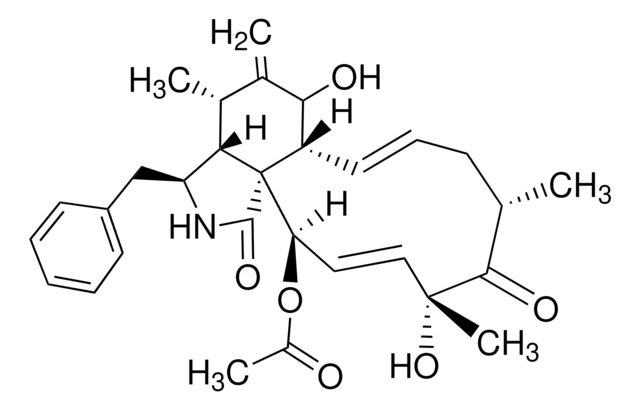203389
Blebbistatin, Racemic
≥97% (HPLC), liquid, Myosin II inhibitor, Calbiochem®
Synonim(y):
InSolutionBlebbistatin, Racemic
About This Item
Polecane produkty
product name
Blebbistatin, Racemic, InSolution, ≥97%, 50 mM in 90% DMSO, reversible inhibitor of nonmuscle myosin II
Poziom jakości
Próba
≥97% (HPLC)
Postać
liquid
producent / nazwa handlowa
Calbiochem®
warunki przechowywania
OK to freeze
desiccated (hygroscopic)
protect from light
Warunki transportu
wet ice
temp. przechowywania
−20°C
Opis ogólny
Działania biochem./fizjol.
ATPase
Opakowanie
Ostrzeżenie
Postać fizyczna
Rekonstytucja
Inne uwagi
Kovacs, M., et al. 2004. J. Biol. Chem.279, 35557.
Straight, A.F., et al. 2003. Science299, 1743.
Cheung, A., et al. 2001. Mol. Biol. Cell Suppl.12, 271a.
Informacje prawne
Kod klasy składowania
10 - Combustible liquids
Klasa zagrożenia wodnego (WGK)
WGK 1
Temperatura zapłonu (°F)
188.6 °F - closed cup - (Dimethylsulfoxide)
Temperatura zapłonu (°C)
87 °C - closed cup - (Dimethylsulfoxide)
Certyfikaty analizy (CoA)
Poszukaj Certyfikaty analizy (CoA), wpisując numer partii/serii produktów. Numery serii i partii można znaleźć na etykiecie produktu po słowach „seria” lub „partia”.
Masz już ten produkt?
Dokumenty związane z niedawno zakupionymi produktami zostały zamieszczone w Bibliotece dokumentów.
Nasz zespół naukowców ma doświadczenie we wszystkich obszarach badań, w tym w naukach przyrodniczych, materiałoznawstwie, syntezie chemicznej, chromatografii, analityce i wielu innych dziedzinach.
Skontaktuj się z zespołem ds. pomocy technicznej






